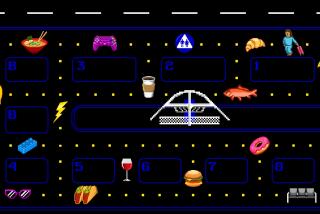The Only Way to Fly
- Share via
In a moment of candor an airline executive described a key feature of modern air service, the hub-and-spoke system, and commented: “The fact that we tried to put 12 pounds in a 10-pound bag is what causes the traveler a problem.” Or, as the laws of physics dictate, two airliners cannot occupy the same airport gate at the same time. The result often is that an arriving plane waits on the runway while a departing plane loads and clears the gate.
Any regular traveler knows that a routine flight these days may wind up in the twilight zone, the wonder world where airlines keep their planes full through the use of spokes and hubs. The frustration of a delay is bad enough, but it becomes particularly acute if the passenger misses a connecting flight as a result. And the domino theory comes into full play whenever airport congestion is compounded by bad weather delays. A snowstorm on the Atlantic Seaboard can disrupt air travel nationwide for a whole day or more.
There is plenty of blame to go around. The airlines blame the air-traffic-control system for failing to move airplanes into and out of busy airports fast enough. Air controllers blame airlines for squeezing too many flights into too few airport gates. But the airlines bear the brunt of passenger ire, since the controllers are out of the line of fire. Any observer can look at the flight departure-and-arrival monitors at the airport and discern the number of flights that are scheduled to land and depart at virtually the same moment. It just does not seem possible. Well, it isn’t.
And, yes, passengers are at fault, too. New customers are not used to the system, and clog ticket-counter lines. Too many passengers try to carry too much bulky baggage on board for stowage in overhead racks. Travelers who should know better show up at the last minute. Everyone is grumpy because flying isn’t the fun that it used to be. But the hub-and-spoke system has allowed airlines to offer bargain fares in a frantically competitive situation and still make a profit.
The system was outlined this way in a speech by TWA executive Richard D. Pearson, who since has gone with American: “TWA’s hub is in St. Louis. Omaha and other spoke cities surround the hub. At 8 a.m., 80 people are on the airplane from Omaha going to St. Louis. TWA offers 80 destinations out of St. Louis and, just for a drill, say that the 80 people all want to go to a different destination offered from St. Louis on a one-stop connection. If all the other 80 flights coming into that hub that morning did the same thing, all of our airplanes would be full all the time, and everyone would be able to go to their destinations.”
But the air routes into St. Louis and the gates would go into overload and delays become endemic. Passengers may be willing to put up with a plane change, but not if it means waiting for hours for the connecting flight. Since transfer to another line usually means a daunting hike to a distant terminal, the originating airline holds the passenger captive.
The federal government has attempted with limited success to negotiate schedule changes to alleviate the congestion. Congress is considering legislation to improve the air-traffic-control system, but that will take years. There will be no return to airline regulation as it was before 1978, and much of the problem will have to be self-correcting over time. This may occur as airline consolidation results in four or five surviving giants, as Pearson predicts, that do not feel that they have to compete with each other for every route.
The smart airlines will do some self-correcting as soon as possible, and will win passenger loyalty through offering the best service. Local airport governing bodies might speed the process by charging the airlines premium fees for gate use at the most congested travel hours.
In the meantime, caveat emptor . Prudent passengers will retain their sanity only through self-survival. They will get to the airport and check in early to avoid being bumped from overbooked flights, will allow adequate time for changing planes, and will travel light with carry-on luggage or will factor in delays at the baggage counters. And--oh, yes--have a nice day.
More to Read
Sign up for The Wild
We’ll help you find the best places to hike, bike and run, as well as the perfect silent spots for meditation and yoga.
You may occasionally receive promotional content from the Los Angeles Times.






